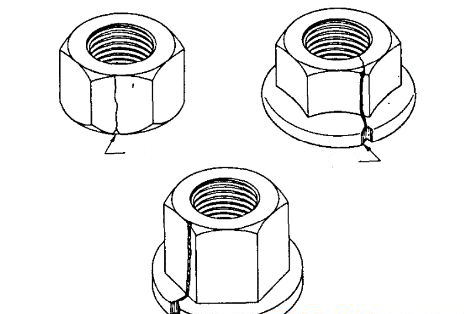3. Burst

Burst is also a crack on the metal surface.
Causes for bursting: during the forging process, due to surface defects of the raw materials, bursting may occur, such as on the outer surface of the nut or on the periphery of the flange face nut.
Note: If the crack caused by the raw material is connected to the burst, the crack may extend to the top circumference, but the burst must not extend. Bursting on the diagonal should not reduce the diagonal width below the specified minimum size.
The width of the burst at the junction of the top or bottom of the nut and the opposite plane shall not be greater than (0.25+0.02s) mm.
The burst on the periphery of the flange nut shall not extend to the minimum dimension of the diameter of the bearing surface, and its width shall not exceed 0.08dc.
s-width across opposite sides; dc-flange diameter
4. Cracks

Cracks are longitudinal surface defects formed by cracks with narrow wrinkles on a material.
Causes of cracks: Cracks are usually inherent defects in the raw materials for manufacturing fasteners.
Note: The depth of the crack must not exceed 0.05D (D-nominal diameter of thread) for all thread specifications.
5. Wrinkles

Wrinkles are metal folds that appear on the surface of the nut during the forging process.
Causes of wrinkles: In the process of forging the nut, at or near the junction where the diameter (cross section) changes, or the top or bottom surface of the nut, wrinkles may occur due to the displacement of the material.
Note: The wrinkles at the junction of the flange around the flange nut and the supporting surface shall not extend to the supporting surface. Other type of the wrinkles are allowed.
6. Dent

Dent is a shallow pit or depression on the surface of the nut due to underfilling of metal during the forging or upsetting process.
Causes of dents: dents are traces or imprints caused by chips or shearing burrs or the rust layer of raw materials, and cannot be eliminated in the forging or upsetting process.
Note: The depth h of the dent (h≤0.02D or the maximum is 0.25mm); the area of the dent: the sum of the dent area on the supporting surface should not exceed 5% of the total area of the supporting surface. Nuts ≤24mm; 10% of the total area of the bearing surface, for nuts with a nominal thread diameter D>24mm. (D-thread nominal diameter)
7. Cut marks

The cut is a shallow groove in the longitudinal or circumferential direction.
Causes of cut marks: cut marks are caused by the relative movement between the manufacturing tool and the workpiece.
Note: The surface roughness of the cut marks on the nut supporting surface should not exceed Ra=3.2μm (according to GB/T1031). Cut marks on other surfaces are allowed.
8. Damage
Damage refers to nicks on any surface of the nut.
Causes of damage: such as dents, scratches, nicks and gouges, caused by external influences during the manufacturing and transportation of the nut.
Appearance drawing: There is no accurate geometry, position or direction, and it is impossible to identify external factors.
Note: The above-mentioned damage should not be rejected unless it can be proved to weaken the performance and usability of the produced crystal. If necessary, follow special agreements, such as packaging requirements, to avoid damage during transportation.